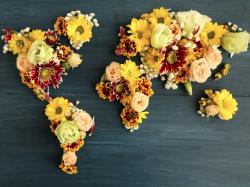World Floriculture Map 2016: Equator Countries Gathering Speed
November 14, 2016 | 1 min to read

Rabobank’s 2016 World Floriculture Map, published in cooperation with Royal FloraHolland, highlights some key global trends in the very diverse floriculture sector. On the consumption side of the business, the rise of online floriculture sales is definitely one of these trends. Although the US floriculture market is showing signs of recovery, the total global floriculture market is still rather fickle. In Europe, the picture is very varied. The Russian market has been declining, resulting in decreasing and changing cut flower imports. The Netherlands is still a major junction in global cut flower trade, but the four cut flower exporters close to the equator—Colombia, Kenya, Ecuador and Ethiopia—are gathering speed. Colombia is also steaming ahead and has become a frontrunner in cut-flower sea freight. Looking at the future, predictability will become more difficult. Therefore, companies in the global floriculture market must be prepared for the unexpected.
Floriculture sector is extremely diverse
The ornamental plant sector is very diverse and includes the production of floral crops such as cut flowers and cut foliage, flower bulbs, potted flowering as well as foliage plants and bedding plants. Global floral production value is estimated at USD 55bn. Tree nursery—the production of trees, shrubs and other hardy plants—is worth another USD 35bn. But whereas cut flowers, cut foliage and flower bulbs are traded globally, mainly from south to north, more bulky live plants, such as potted plants and nursery products, are mainly traded regionally (see Figure 1).
To read the rest of the story, please go to: Rabobank
